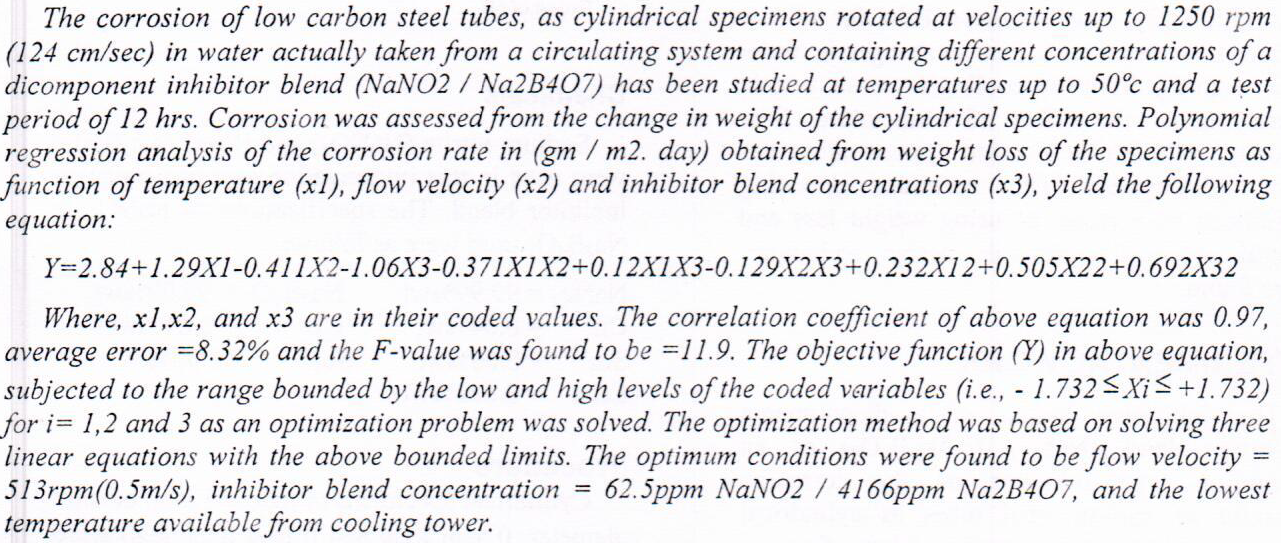
Thermal energy storage is an important component in energy units to decrease the gap between energy supply and demand. Free convection and the locations of the tubes carrying the heat-transfer fluid (HTF) have a significant influence on both the energy discharging potential and the buoyancy effect during the solidification mode. In the present study, the impact of the tube position was examined during the discharging process. Liquid-fraction evolution and energy removal rate with thermo-fluid contour profiles were used to examine the performance of the unit. Heat exchanger tubes are proposed with different numbers and positions in the unit for various cases including uniform and non-uniform tubes distribution. The results show that
... Show More (13)
(13)
 (13)
(13)
been taken at room temperature down to liquid nitrogen temperature (77K). Polar and nonpolar solvents have been used to study the solvent effect on the absorption and fluorescence spectra of solute molecules. Some of the spectroscopic parameters have been determined as functions of solvent polarity and temperature. The results indicate that the band width FWHM increases with increasing the solvent polarity and temperature, while the peak emission cross section decreases with increasing of solvent polarity and decreases with increasing the temperatures. Clear vibrational structure spectra of benzoanthracene molecules have been observed in Nonane and Hexane solvents at 77K.
Stabilization of phenol trapped by agricultural waste: a study of the influence of ambient temperature on the adsorbed phenol
 (24)
(24)
 (4)
(4)
Crude oil is one of the most important sources of energy in the world. To extract its multiple components, we need oil refineries. Refineries consist of multiple parts, including heat exchangers, furnaces, and others. It is known that one of the initial operations in the refineries is the process of gradually raising the temperature of crude oil to 370 degrees centigrade or higher. Hence, in this investigation the focus is on the furnaces and the corrosion in their tubes. The investigation was accomplished by reading the thickness of the tubes for the period from 2008 to 2020 with a test in every two year, had passed from their introduction into the work. Where the thickness of more than one point was measured on each tube in the sa
... Show More (6)
(6)
 (7)
(7)
The inhibitor property of curcuma longa L. extract in different concentrations of simulated refinery wastewater (0.05% - 2% wt) and at various temperatures (30, 35 and 40 ˚C) was investigated using weight loss method. The results showed that the presence of about 1.2 % (v/v) of curcuma extract gave about 84% inhibition indicating its effectiveness on mild steel corrosion in simulated refinery wastewater, besides the adsorption process on the mild steal surface obeyed the Langmuir adsorption isotherm.
The effect of mixed corrosion inhibitors in cooling system was evaluated by using carbon steel specimens and weight loss analysis. The carbon steel specimens immersed in mixture of sodium phosphate (Na2 HPO4) used as corrosion inhibitor and sodium glocunate (C6 H11 NaO7) as a scale dispersant at different concentrations (20,40, 60, 80 ppm) and at different temperature (25,50,75 and 100)ºC for (1-5) days. The corrosion inhibitors efficiency was calculated by using uninhibited and inhibited water to give 98.1%. The result of these investigations indicate that the corrosion rate decreases with the increase the corrosion inhibitors concentration at 80 ppm and at 100ºC for 5 days, (i.e,
... Show More (3)
(3)
 (1)
(1)


